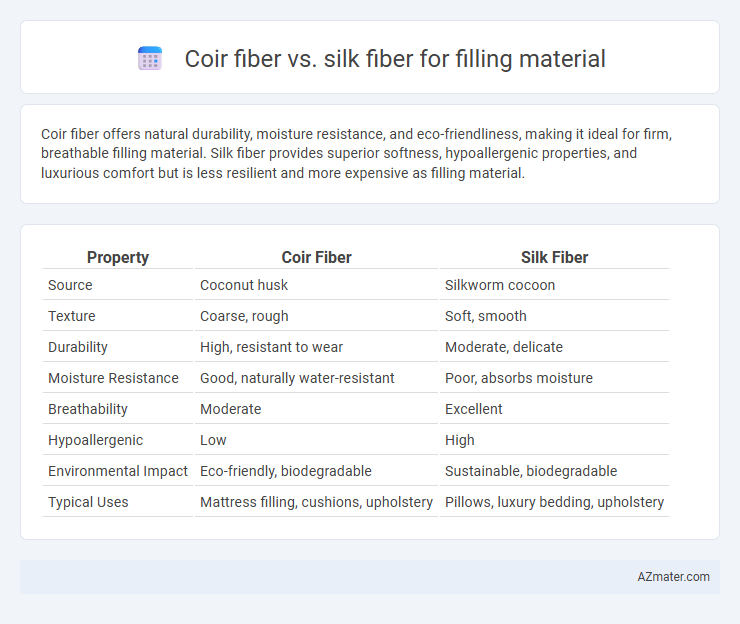Coir fiber offers natural durability, moisture resistance, and eco-friendliness, making it ideal for firm, breathable filling material. Silk fiber provides superior softness, hypoallergenic properties, and luxurious comfort but is less resilient and more expensive as filling material.
Table of Comparison
| Property | Coir Fiber | Silk Fiber |
|---|---|---|
| Source | Coconut husk | Silkworm cocoon |
| Texture | Coarse, rough | Soft, smooth |
| Durability | High, resistant to wear | Moderate, delicate |
| Moisture Resistance | Good, naturally water-resistant | Poor, absorbs moisture |
| Breathability | Moderate | Excellent |
| Hypoallergenic | Low | High |
| Environmental Impact | Eco-friendly, biodegradable | Sustainable, biodegradable |
| Typical Uses | Mattress filling, cushions, upholstery | Pillows, luxury bedding, upholstery |
Overview of Coir Fiber and Silk Fiber
Coir fiber, derived from the outer husk of coconut shells, is a natural, coarse, and resilient material often used in mattresses and upholstery for its durability and moisture resistance. Silk fiber, produced by silkworms, is a smooth, soft, and lightweight protein fiber prized for its breathability, hypoallergenic properties, and luxurious feel in high-end bedding and clothing. Both fibers serve distinct purposes in filling materials, with coir offering firm support and moisture wicking, while silk provides softness and temperature regulation.
Source and Production Processes
Coir fiber, derived from the outer husk of coconut shells, undergoes a natural retting process followed by drying and defibring to produce coarse, durable strands ideal for mattress and upholstery fillings. Silk fiber, sourced from the cocoons of Bombyx mori silkworms, is produced through sericulture involving rearing silkworms, harvesting cocoons, and carefully unwinding the protein filament to maintain its fine, smooth texture. The extraction of coir involves mechanical decortication, while silk production emphasizes delicate manual unwinding, resulting in distinctly different fiber characteristics suited for varied filling applications.
Physical Properties Comparison
Coir fiber exhibits high durability, coarse texture, and excellent moisture resistance, making it ideal for firm and resilient filling materials, while silk fiber offers a soft, smooth texture with superior elasticity and hypoallergenic properties, enhancing comfort and cushioning. Coir's higher density and stiffness provide strong structural support compared to the lightweight, flexible nature of silk fiber, which contributes to better pressure distribution and softness. The thermal insulation of coir is moderate, whereas silk fibers excel in breathability and temperature regulation, impacting overall filling material performance in different applications.
Comfort and Breathability
Coir fiber offers high breathability due to its natural hollow structure, promoting excellent air circulation and moisture wicking, which enhances comfort in warm climates. Silk fiber provides superior softness and temperature regulation, adapting to body heat for a luxurious, comfortable feel. While coir fiber is more durable and resistant to mold, silk fiber excels in lightweight comfort and smooth texture, making them suitable for different filling material preferences.
Durability and Longevity
Coir fiber exhibits superior durability and longevity compared to silk fiber due to its natural stiffness and resistance to moisture, making it ideal for long-term filling material in mattresses and cushions. Silk fiber, while luxurious and soft, tends to degrade faster with exposure to humidity and pressure, limiting its lifespan in high-use applications. The robust structure of coir fiber ensures consistent performance and shape retention over years, whereas silk requires more careful maintenance to preserve its integrity.
Eco-Friendliness and Sustainability
Coir fiber, derived from coconut husks, is an eco-friendly and sustainable filling material due to its biodegradability and renewable sourcing, making it a low-impact alternative to synthetic fillers. Silk fiber, although natural and biodegradable, requires intensive labor and resources for cultivation, impacting its sustainability compared to coir fiber's efficient production cycle. The durability and natural resistance of coir fiber to pests and moisture further enhance its environmental benefits over silk fiber in filling applications.
Hypoallergenic Qualities
Coir fiber, derived from coconut husks, offers natural hypoallergenic properties by resisting dust mites and mold, making it ideal for allergy-sensitive fillings. Silk fiber, produced from silkworm cocoons, is naturally hypoallergenic due to its protein structure that inhibits bacterial growth and repels dust mites. Both fibers provide excellent alternatives to synthetic fillings, but silk fiber's finer texture often results in superior comfort and reduced allergenic reactions.
Cost Analysis
Coir fiber offers a cost-effective alternative to silk fiber for filling material, with prices averaging 70-80% lower due to its abundant availability and lower production costs. Silk fiber, although luxurious and softer, incurs significantly higher expenses driven by labor-intensive harvesting and processing techniques. When evaluating cost efficiency for large-scale applications, coir fiber presents substantial savings without compromising on durability or cushioning performance.
Common Applications in Filling Materials
Coir fiber is commonly used in mattresses, upholstery, and cushions due to its natural resilience, firmness, and moisture resistance, making it ideal for providing firm support and durability. Silk fiber is favored for high-end bedding and luxury pillows because of its lightweight softness, hypoallergenic properties, and excellent temperature regulation, offering enhanced comfort and breathability. Both fibers serve distinct roles in filling materials, with coir prioritized for structural support and silk for premium comfort.
Choosing the Right Fiber for Your Needs
Coir fiber offers exceptional durability and natural moisture resistance, making it ideal for firm, eco-friendly mattress and cushion fillings that require breathability and longevity. Silk fiber provides a luxurious softness and excellent temperature regulation, perfect for lightweight, hypoallergenic pillows and bedding suitable for sensitive skin. Selecting the right fiber depends on the desired comfort level, firmness, and maintenance preferences, with coir excelling in support and silk in plushness and thermal comfort.

Infographic: Coir fiber vs Silk fiber for Filling Material
 azmater.com
azmater.com